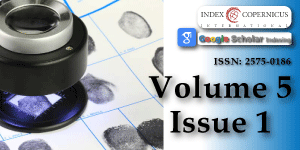Environmental influence on blood serum detection using ultraviolet 365
Main Article Content
Abstract
The major use of alternative light sources (ALS) in the evaluation of bloodstains has been primarily focused on detection of whole blood, with relatively little attention to visualization of blood serum. Serum may become separated from blood pools during clotting, and because it is relatively invisible on certain backgrounds, go undetected by a perpetrator attempting to clean up a crime scene. Recently, Ultraviolet 365 (UV 365) was shown to be an effective tool in blood evaluation, useful for detection of even minute quantities of blood serum. Here the effects of environmental conditions on blood serum stain appearance were evaluated, including temperature, pH, protease sensitivity, solubility, and aging. Interestingly, it was found that the UV fluorescence of serum increases upon exposure to heat, which was accompanied by color changes under visible light and decreased solubility in multiple solvents. The efficiency of visualization of serum stains was somewhat variable, depending on the type of material on which it was dried. Finally, the current study documents the effect of heating on formation of fluorescent serum halo rings in dried bloodstains. Taken together, these data demonstrate that blood serum detection may be affected by certain conditions that influence its visualization under both visible and UV light.
Article Details
Copyright (c) 2021 Kearse KP

This work is licensed under a Creative Commons Attribution 4.0 International License.
Kearse KP. Ultraviolet 365 as an Alternative Light Source for Detection of Blood Serum. J Forensic Sci. 2020; 65: 1716-1721. PubMed: https://pubmed.ncbi.nlm.nih.gov/32343369/
Saito M, Taira H. Heat Denaturation and Emulsifying Properties of Plasma Protein. Agric Biol Chem. 1987; 51: 2787-2792.
Brady T, Tigmo J, Graham G. Extreme Temperature Effects on Bloodstain Pattern Analysis. I.A.B.P.A Newsletter. 2002; 3-20.
Borzova VA, Markossian KA, Chebotareva NA, Kleymenov SY, Poliansky NB, et al. Kinetics of Thermal Degradation and Aggregation of Bovine Serum Albumin. PloS One. 2106; 11: e0153495. PubMed: https://pubmed.ncbi.nlm.nih.gov/27101281/
Larkin BAJ, Banks CE. Preliminary Study on the Effect of Heated Surfaces Upon Bloodstain Pattern Analysis. J Forensic Sci. 2013; 58: 1289-1296. PubMed: https://pubmed.ncbi.nlm.nih.gov/23865610/
Tontarski KL, Hoskins KA, Watkins TG, Brun-Conti L, Michaud AL. Chemical Enhancement Techniques of Bloodstain Patterns and DNA Recovery after Fire Exposure. J. Forensic Sci. 2009; 54: 37-48. PubMed: https://pubmed.ncbi.nlm.nih.gov/19018938/

